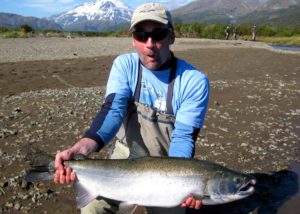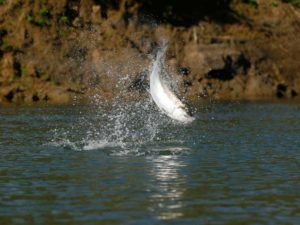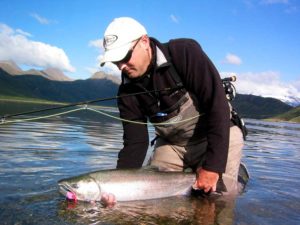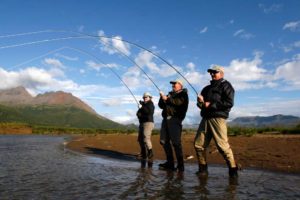Epic Blog
Seven Species Series: Silver Salmon
09.14.20
Part Seven: Silver Salmon
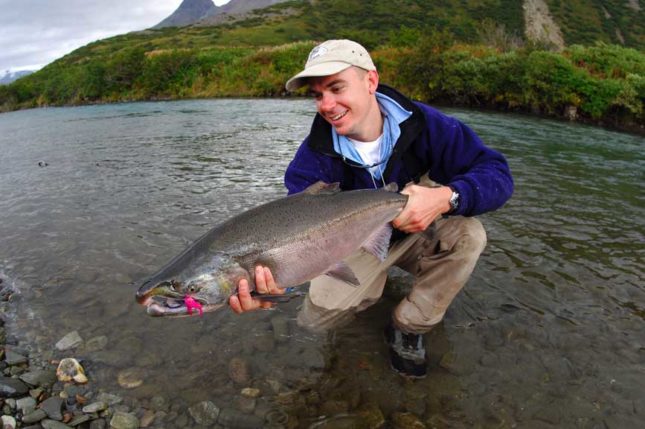
Catching silver salmon is like catching rainbow trout, but 10 or 12 pounds, over and over again. Photo by Tosh Brown.
Late September, 2017. The pleasantly warm and perpetually light filled days of the early season are now long gone. A cold damp chill permeates the air. The darkness of evening comes on suddenly, and for the first time in months all of the starry firmament is visible overhead on the nights that boast a clear sky. Ursa Major reins supreme, dominating the northern heavens as it rises over the black silhouette of the big mountain. By day you can see clearly the hills and ridges that lay across the yawning expanse of the valley have faded from their once viridescent grandeur to rust.
Storm’s a coming
Autumn has come to the Alaska Peninsula and with it has come foul weather. Storms born out over the sea become more frequent and severe as they line up en masse to unleash their furry on the coast. They blow in from the south, lashing the long arm of the Peninsula as they cartwheel up the rugged coastline, slowly churning their way through the Shelikof Straits and into the Gulf of Alaska. The rivers rise with the torrents of rain that can occasionally last for days and nights on end. Sometimes the creek can withstand the onslaught, sometimes it’s too much.
Soon the worst has passed. The storm blows itself out. The rain tapers off and the rivers begin to recede back to their normal levels, turning green once more. A new flood comes rushing in out of the sea now. A late arrival, but one that is always worth waiting for.
All that glitters is not always gold
There will be a day during the SAFARI season when the first silver is caught. Sometimes this happens during the first week. Sometimes it isn’t until the end of the second. Usually it begins with a trickle. You see a handful holding in the deeper pools and troughs of the creek on your way up river with clients to fish for Dolly Varden. If there is sun on the water the sight of them will stop you dead in your tracks; with their backs set aglow as if belonging to that of some tropical fish, pulsating with aqua green opalescence below the waters surface like a sapphire in the mine.
Later, once the storms of Autumn begin to bear down on the isolated bays and drainages of the rugged Pacific coast of the peninsula, that trickle of silvers will cascade into a flood.
Silvers
Silver salmon, coho or simply silvers, are a member of the Pacific Salmon genus Oncorhynchus. Their traditional range spans from the central California coast north along the Pacific and into the seas of Russia and coasts of Hokkaido, Japan. In California they are now critically endangered and encounters with them are exceedingly rare, but in Alaska they remain plentiful. Up here they are the last salmon to return to spawn. On the Pacific coast, they typically show up sometime in mid August and run strong through September; runs may even linger into November. It’s worth mentioning that silvers are present at our first camp, we’re just never there late enough in the season to target them.
They are known among anglers as being especially good sport on light tackle. Silvers are belligerent fighters once hooked. Often exploding out of the water in a melee of acrobatic summersaults and line ripping runs. Once fixated on a fly they do not need much coaxing before giving chase, often throwing a v-wake off of their back in hot pursuit before detonating on the helpless offering. When the fishing is at its peak this scenario repeats itself over and over again, providing a never ending thrill for the lucky angler standing on the bank.
Poppers and wogs
One of the most unique aspects of fly fishing for silvers is their propensity to look up and give chase to a top water pattern. Typically top water patterns for silvers will be some combination of spun deer hair and foam. Pink is the predominant color of choice, although chartreuse can have its day in court as well. Finding a deeper pool or trough with slower current seems to be best for consistent top water action. Sometimes, especially under bright sunny conditions the game can be finite. Other times, sun or overcast skies, it can be gangbusters. Finding a batch of fresher fish off the most recent tide probably helps, but I’ve also seen good top water fishing for silvers in some of the higher reaches of our creek.
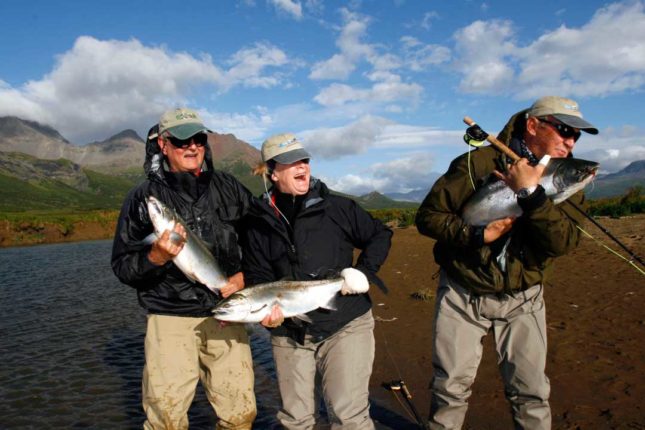
When trying to capture a silver threesome there’s usually more comedy than cooperation! Photo by Johnny Quiroz.
When stars align
All of fishing is based on conditions. You can have an armada of salmon parked in a pool but that does not mean they will be inclined to bite at your fly. You can have perfect light and water conditions but struggle to find where the fish are holding.
Sometimes it all coalesces into one perfect day when the tides, weather, and fish align like orbiting planets. Imagine a fall day in the far north. The crisp clean air of autumn with its stark sunlight filtering through the few wispy morning clouds. A calm sea with its lulling surf break humming rhythmically. The volcano beaming in the distance with fresh coats of snow blanketing its flanks from the night before. Below the outgoing tide is just starting to crank up into full throttle. Just a short jaunt from our camp, up the shoreline and around the rocky point that juts out into the tidal estuary where the current has carved away a deep hole, hundreds of sea bright silver salmon begin to stir.
Fever pitch
As the tide recedes the silvers push out of the deep hole and begin to run up the straight away to where a gravel island is slowly beginning to emerge. All three guides spread out all nine clients along the line like soldiers forming a marching column. The action begins immediately. Soon the fishing reaches a fever pitch. Every rod is bent to the cork up and down the line as more and more fish flood into the shallow riffles. It remains that way for the duration of the outgoing tide and then continues into the slack phase and beginning of the incoming. Finally the tide reaches a tipping point and floods in past the rocky point. The fish disperse. Hunting seals venture into the flat hoping to spring their ambush. Now it is their turn.
Find more Machete articles here.
Posted in All Posts, Fishing, SAFARI



